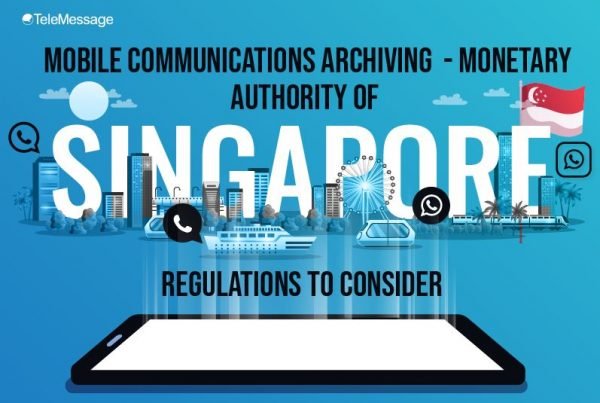Despite the security and compliance concerns it poses, mobile messaging in the workplace is undoubtedly here to stay. Just as smartphones and messaging apps have become prevalent in our personal lives, it’s no wonder that mobile messaging has become a tool of choice in many offices as well.
With the widespread smartphone adaption, the growing BYOD trend, and common use of text and instant messaging, workplace mobile messaging cannot be ignored, especially by CIOs and IT Managers. It is important to keep updated with how mobile messaging is changing the way employees communicate in the workplace and adopt the right platform that will enable the business to remain compliant with various archiving regulations – all without disrupting the productivity of the company.
Here are the latest trends in mobile messaging and archiving that currently take place in most workplaces in 2018.

1. Less Use of Email – Serious Growth in Mobile Messaging Apps
The 2018 State of Inbound Report from HubSpot highlights that from 2016 to 2018, there have been slight decreases in employees’ preferences to communicate business-related messages without the use of messaging apps. In fact, it was the only channel to grow, from 29% in 2016 to 32% in 2018.
Email usage, on the other hand, continues to decrease – from 88% in 2016, 86% in 2017, and to 83% in 2018.
Text messaging, however, registered as the most requested communication channel last year. In 2017, 42% of employees asked their company to allow them to use SMS messaging at work, a significant increase from 21% in 2016.
2. Rapid Increase of Millennial Workforce and Consumers
One of the key drivers for the growth in mobile messaging apps and text messaging usage in the workplace is the rapid increase of millennial workforce and consumers.
In fact, 68% of millennials admit to texting a lot, compared to 47% of their Gen X counterparts. A survey from OpenMarket also found that 75% of millennials would also choose a text-only phone over voice-only phone.
Other interesting statistics about millennials and their preferred communication channels are as follows:
- 34% of millennials would prefer a brand that uses social media versus only 16% of older demographics (Association of National Advertisers, Barkley, SMG, BCG)
- 60% of millennials prefer two-way text as a means of engagement with companies because it’s convenient, fast, and easy. (OpenMarket)
- OpenMarket also found that 83% of Millennials would prefer to text a company’s 1-800 customer service line versus waiting on hold.
As the millennial workforce grows and earns higher wages, businesses will need to adapt to the communication channels they use if they want to succeed with this particular demographic.
3. C-Level Executives Starting to Adopt Social and Mobile Messaging Apps
As the proliferation of messaging apps in workplace seemingly only increase each year, many CEO’s have already started to carry on the trend in order to stay connected with their employees and customers.
From the same HubSpot study, it was revealed that C-Level executives are the biggest users (compared to VP/Directors, Managers, and Individual contributors) of messaging apps, with 39% preferring to communicate via social media and 35% on messaging apps.
The findings suggest that senior leaders are more keen to try and test new technologies, especially those considered the next big thing. Messaging apps and social media also allow quick and informal communication – features that are important to people who are on-the-go and in a position to dictate requests.
As more top-level executives favor the use of mobile messaging, we can expect to see wider adoption of messaging apps for internal staff communication in the future.
4. Addressing Compliance Risks Via Mobile Archiving Platforms
While these statistics are essential for all businesses that plan to integrate mobile messaging in their core communication and marketing strategy, they are also particularly impactful for heavily regulated businesses such as Financial Services firms where compliance and supervision of business-related communications are mandated by FINRA and the SEC.
Firms adopting the use of mobile messaging apps and text messaging for business communication will need to capture, retain, and actively supervise and produce content when required. But despite the hefty fines that non-compliance with these regulations carry, a significant portion of organizations still lack the right technology and policies in place to facilitate mobile communications archiving.
According to statistics, 48% of companies still don’t have an archiving/supervision solution in place. Among those that do not allow such texting and mobile messaging in their workplace, only 33% are confident that their prohibition policies are working.
Businesses that do not use mobile messaging apps and text messaging will be at a serious disadvantage when competing against those that do. Fortunately, mobile archiving platforms such as TeleMessage that enable organizations to archive not only email but also content from social media channels and text messaging.
Conclusion
With these trends, we can expect that more businesses will adopt messaging apps in the years to come, and the impact this will have on other communication channels. If your business is not using any secure messaging apps, it’s definitely worth exploring how they could be incorporated into your communication efforts, especially considering most apps are now expanding functionality to connect companies with users.
To learn more about our enterprise messaging platforms, visit our website today at www.telemessage.com


